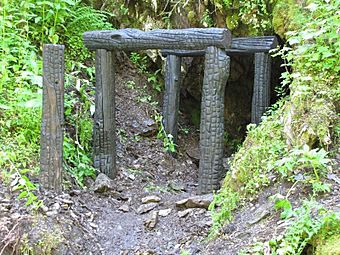Edward Pulaski Tunnel and Placer Creek Escape Route facts for kids
Quick facts for kids |
|
|
Edward Pulaski Tunnel and Placer Creek Escape Route
|
|

Pulaski Tunnel entrance, restored in 2010
|
|
| Location | West Fork Placer Creek |
|---|---|
| Nearest city | Wallace, Idaho |
| Area | 12 acres (4.9 ha) |
| Built | 1910 |
| MPS | North Idaho 1910 Fire Sites TR |
| NRHP reference No. | 84001179 |
| Added to NRHP | September 20, 1984 |
The Edward Pulaski Tunnel and Placer Creek Escape Route are two important places. They were used by United States Forest Service firefighter Edward Pulaski during the huge Great Fire of 1910. Pulaski used these spots to save himself and most of his team from the raging fire.
These sites are located south of Wallace, Idaho. You can find them in the Idaho Panhandle National Forests. The Pulaski Tunnel and escape route were added to the National Register of Historic Places in 1984. This means they are recognized as important historical sites.
Contents
What Was the Great Fire of 1910?
The summer of 1910 was very hot and dry. This made the risk of wildfires extremely high across the western United States. By August, about 1,400 wildfires were burning out of control. These fires were in northern Idaho, northeastern Washington, and northwestern Montana.
On August 20, some of these wildfires grew into massive firestorms. A firestorm is a very intense fire that creates its own strong winds. These firestorms threatened many small towns and trapped firefighting crews. One of these trapped crews was led by Ed Pulaski.
How Did Pulaski Save His Crew?
Pulaski and his 45-man crew were fighting a fire near Placer Creek. This was about 10 miles (16 km) southwest of Wallace. When the fire became too dangerous, Pulaski told his men to go towards Wallace. But as they left, another fire blocked their path. They were surrounded!
Pulaski knew the area well. He quickly led his men through the burning forest to an old, abandoned mine. The crew, along with two horses, went into the mine opening. They entered just as the fire swept over the area.
Inside the Mine: A Safe Place?
The mine was actually a short tunnel used for prospecting. It had been left empty because no valuable ore was found there. The mine entrance was about 6 feet (1.8 m) high and 5 feet (1.5 m) wide. The tunnel was only 250 feet (76 m) long. But this short tunnel was enough to protect Pulaski and his crew.
As the fire roared outside, the heat made the cool air in the tunnel rush out. Hot air and smoke then filled the tunnel. Pulaski told his men to lie down on the floor. There was still some air they could breathe close to the ground.
The fire got very close to the tunnel entrance. Wooden beams at the entrance started to burn. Pulaski used his hat to carry water from small puddles on the mine floor. He tried to put out the flames. He was badly burned while doing this. Eventually, Pulaski and all his men passed out.
The Morning After
The next morning, Pulaski woke up and counted his men. Thirty-nine of them were alive. Sadly, one of his crew had been killed by a falling tree on the way to the mine. Five others had died from breathing too much smoke during the night. The two horses also died.
After the fire in the forest died down, Pulaski and his crew followed Placer Creek to safety in Wallace.
The Impact of the Great Fire
In just two days, the Great Fire of 1910 burned 3,000,000 acres (1,200,000 ha) of forest. The six men who died in or near Pulaski's tunnel were among 78 firefighters killed by the fire. Seven other people who were not firefighters also died. This brought the total number of lives lost to 85.
The Pulaski Tunnel and escape route are important because of their connection to Ed Pulaski and the Great Fire of 1910. They were added to the National Register of Historic Places in 1984.
Restoring the Pulaski Tunnel Trail
For many years, you could only see two historical signs about Pulaski's escape route. These signs were along a forest road south of Wallace. In 2002, a group of citizens decided to restore Pulaski's tunnel. They also wanted to make the trail to the site better. This effort was called the Pulaski Project.
The Forest Service joined the project and started working on the trail in 2005. Since then, the entire trail has been cleared and smoothed out. Five bridges have been built along the trail. There are also a dozen signs that tell you about Pulaski, the 1910 fire, and other interesting things you can see. At the start of the trail, there's a parking area and a restroom.
Today, the trail is only for walking. From the start of the trail, the hike to the tunnel is about 2 miles (3.2 km). This means a round-trip hike is about 4 miles (6.4 km). The trail goes up about 800 feet (240 m) in height. This makes the hike a bit challenging, but it's a great way to learn history! The trailhead is located just off Forest Road 456, about 1 mile (1.6 km) south of Wallace, Idaho.
Images for kids








